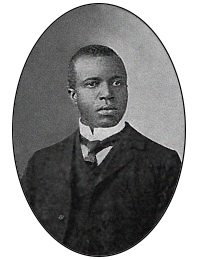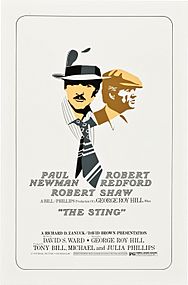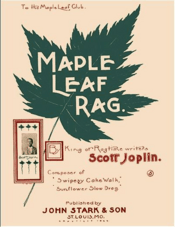Scott Joplin facts for kids
Quick facts for kids
Scott Joplin
|
|
|---|---|

Joplin in 1903
|
|
| Born | November 24, 1868 Texarkana, Texas, U.S., or Linden, Texas, U.S. (disputed)
|
| Died | April 1, 1917 (aged 48) Manhattan, New York City, U.S.
|
| Burial place | St. Michael's Cemetery |
| Education | George R. Smith College |
| Occupation |
|
| Years active | 1895–1917 |
| Spouse(s) |
Belle Jones
(m. 1899; div. 1903)Freddie Alexander
(m. 1904; died 1904)Lottie Stokes
(m. 1909) |
| Awards | Pulitzer Prize (posthumous, 1976) |
| Signature | |
Scott Joplin (c. 1868 – April 1, 1917) was an American composer and pianist. Because of the fame achieved for his ragtime compositions, he was dubbed the "King of Ragtime". One of his first and most popular pieces, the "Maple Leaf Rag", became the genre's first and most influential hit, later being recognized as the quintessential rag.
Contents
Early life
Joplin was born in Texas, U.S., to Giles Joplin, a former slave from North Carolina, and Florence Givens, a freeborn African-American woman from Kentucky. He was the second of six children. His birth date is uncertain and is most commongly believed to be November 24, 1868.
By 1880, the Joplins moved to Texarkana, Arkansas, where Giles worked as a railroad laborer and Florence as a cleaner. Joplin's father had played the violin for plantation parties in North Carolina and his mother sang and played the banjo. Joplin got some musical education from his family, and from the age of seven he was allowed to play the piano while his mother cleaned.
In the early 1880s, Giles Joplin left the family for another woman and Florence struggled to support her children through domestic work. She supported her son's musical interest, while his father wanted the boy to pursue a more practical career.
According to a family friend, the young Joplin was serious and ambitious studying music and playing the piano after school. While a few local teachers aided him, he received most of his musical education from Julius Weiss, a German-born American Jewish music professor who had immigrated to Texas in the late 1860s and was employed as music tutor by a prominent local business family. Weiss had studied music at a German university and was listed in town records as a professor of music. He was impressed by Joplin's talent, and taught him free of charge. He tutored Joplin from the ages of 11 to 16, introducing him to folk and classical music, including opera.
Weiss helped Joplin appreciate music as an "art as well as an entertainment" and helped Florence buy a used piano. According to Joplin's widow Lottie, Joplin never forgot Weiss. In his later years, after achieving fame as a composer, Joplin sent his former teacher "gifts of money when he was old and ill" until Weiss died. At the age of 16, Joplin performed in a vocal quartet with three other boys in and around Texarkana, also playing piano. He also taught guitar and mandolin.
Career outline
As teenager, Joplin worked as a railroad laborer. During the late 1880s, he left his job and traveled the American South as a touring musician. He went to Chicago to perform at the World's Fair of 1893, which played a major part in making ragtime a national craze by 1897.
Joplin moved to Sedalia, Missouri, in 1894 and earned a living as a piano teacher. There he taught future ragtime composers Arthur Marshall, Scott Hayden and Brun Campbell. He began publishing music in 1895, and publication of his "Maple Leaf Rag" in 1899 brought him fame. This piece had a profound influence on writers of ragtime. It also brought Joplin a steady income for life.
In 1901, Joplin moved to St. Louis, where he continued to compose and publish and regularly performed in the community. In 1903, the score to his first opera, A Guest of Honor, was confiscated—along with his belongings—for non-payment of bills, (likely as a result of being robbed) and is now considered lost.
In 1907, Joplin moved to New York City to find a producer for a new opera. He attempted to go beyond the limitations of the musical form that had made him famous but without much monetary success. His second opera, Treemonisha, was never fully staged during his life.
Personal life
In 1901, Joplin married his first wife Belle Jones (1875–1903) a sister-in-law of Scott Hayden. In 1903, Joplin's only child—a daughter—died. Joplin and his first wife drifted apart.
In June 1904, Joplin married Freddie Alexander of Little Rock, Arkansas, the young woman to whom he had dedicated "The Chrysanthemum". She died on September 10, 1904, of complications resulting from a cold, ten weeks after their wedding. "Bethena", Joplin's first work copyrighted after Freddie's death, was described by one biographer as "an enchantingly beautiful piece that is among the greatest of ragtime waltzes."
In 1907, Joplin moved to New York City, which he believed was the best place to find a producer for a new opera. After his move to New York, Joplin met Lottie Stokes, whom he married in 1909. Lottie remained his wife until his death in 1917.
Death
By 1916, Joplin had a serious illness. On February 2, 1917, he was admitted to Manhattan State Hospital, a mental institution. The “King of Ragtime” died there on April 1 of dementia at the age of 48 and was buried in a pauper's grave that remained unmarked for 57 years. His grave, located at St. Michael's Cemetery in East Elmhurst was finally given a marker in 1974, the year The Sting, which showcased his music, won Best Picture at the Oscars.

Joplin's death is widely considered to mark the end of ragtime as a mainstream music format; over the next several years, it evolved with other styles into stride, jazz and, eventually, swing.
Legacy
Joplin's music was rediscovered and returned to popularity in the early 1970s with the release of a million-selling album recorded by Joshua Rifkin. This was followed by the Academy Award–winning 1973 film The Sting, which featured several of Joplin's compositions, most notably "The Entertainer", a piece performed by pianist Marvin Hamlisch that received wide airplay. Treemonisha was finally produced in full, to wide acclaim, in 1972. In 1976, Joplin was posthumously awarded a Pulitzer Prize.
Museum
The home Joplin rented in St. Louis from 1900 to 1903 was recognized as a National Historic Landmark in 1976 and was saved from destruction by the local African American community. In 1983, the Missouri Department of Natural Resources made it the first state historic site in Missouri dedicated to African American heritage. At first it focused entirely on Joplin and ragtime music, ignoring the urban milieu which shaped his musical compositions. A newer heritage project has expanded coverage to include the more complex social history of Black urban migration and the transformation of a multi-ethnic neighborhood to the contemporary community.
Interesting facts about Scott Joplin
- During his career, he wrote over 40 original ragtime pieces, one ragtime ballet, and two operas.
- While Joplin never made an audio recording, his playing is preserved on seven piano rolls for use in mechanical player pianos. All seven were made in 1916.
- Joplin also wrote a symphony, but the music has been lost.
Awards and recognition
- 1970: Joplin was inducted into the Songwriters Hall of Fame by the National Academy of Popular Music.
- 1976: Joplin was awarded a special Pulitzer Prize "bestowed posthumously in this Bicentennial Year, for his contributions to American music."
- 1977: Motown Productions produced Scott Joplin, a biographical film starring Billy Dee Williams as Joplin, released by Universal Pictures.
- 1983: the United States Postal Service issued a stamp of the composer as part of its Black Heritage commemorative series.
- 1989: Joplin received a star on the St. Louis Walk of Fame.
- 2002: a collection of Joplin's own performances recorded on piano rolls in the 1900s (decade) was included by the National Recording Preservation Board in the Library of Congress National Recording Registry. The board annually selects songs that are "culturally, historically, or aesthetically significant".
- 2012: a crater on the planet Mercury was named in his honor.
Images for kids
-
Scott Joplin House in St. Louis, Missouri
-
A commemorative plaque to Joplin in Texas
-
Joplin's star on the St. Louis Walk of Fame
See also
 In Spanish: Scott Joplin para niños
In Spanish: Scott Joplin para niños











